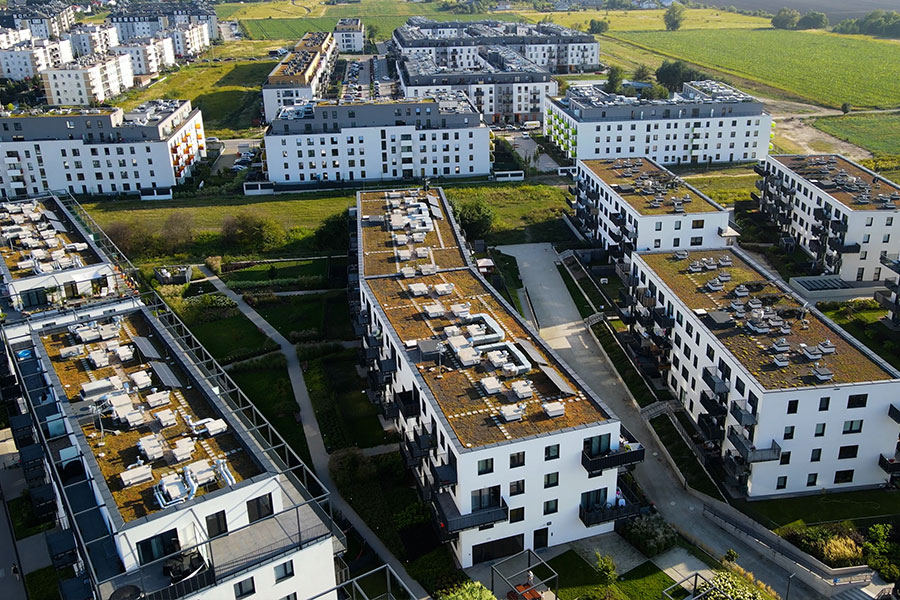In 2025, the Polish economy will gain slightly more momentum, with GDP growth at 4.0%. In our opinion, this will be a consequence of several factors. First, we will see a recovery in investment due to higher public sector spending and simultaneous stabilization of private investment. Second, the negative contribution of net exports will remain so, but on a significantly smaller scale due to the recovery of domestic demand in Poland’s main trading partners. Third, the recovery in domestic consumption will slow down a bit.
External Activity Conditions

Economic growth
The year 2024 was a period of economic recovery following stagnation the year before. According to Statistics Poland’s preliminary estimate, GDP growth amounted to 2.9% yoy. However, the pace of this recovery was historically slow and disappointing compared to forecasts. Despite a rapid increase in real household incomes, reaching 7% annually, private consumption grew relatively slowly (ca. 3% yoy). Investment growth came out at ca. 1% yoydue to the EU funding cycle.
Labour market
The unemployment rate amounted to 5.1% at the end of 2024, compared to 5.1% at the end of 2023. The stagnation of this indicator is a good illustration of the Polish labor market condition in 2024, which showed not only stagnant but also slightly recessionary trends. This was a direct result of the weakening consumer demand from a year ago, low foreign demand, but also rising employment costs. Despite the unfavorable environment, the unemployment rate in 2024 reached its historical minimum twice (4.9%). The lack of its significant increases is the result of the continuing tightness in the labor market and employers anticipating the upcoming economic recovery. As a result, average employment in the enterprise sector in terms of the number of full-time positions fell by 50 thousand, compared to a decrease in the number of employees by only 20 thousand – the discrepancy was due to avoiding layoffs and cutting hours instead.

In the first quarter of 2025, the unemployment rate will increase due to seasonal factors, but will start to fall again at the turn of the first two quarters, to reach its historical minimum in the second half of the year. At the end of 2024, the unemployment rate should fall to 4.8% from 5.1% a year earlier. In turn, wage growth will follow a downward trend, to eventually decrease by about 1 percentage point compared to the previous year. With inflation growing especially at the beginning of the year, real wages will slow down significantly and increase by only 4%. The nominal wages growth in the enterprise sector will decrease in 2024 to about 8.7%. In addition, we forecast an acceleration of the employment growth in the enterprise sector to 0.1% in 2025 from -0.4% in 2024.
Inflation and monetary policy
At the turn of 2023 and 2024, a period of dynamic disinflation, driven by the waning of extraordinary external shocks (pandemic, supply, energy, war-related) and the subsequent decline from a high reference base, especially non-core inflation, came to an end. Consumer inflation (CPI) in March 2024 reached a lower-than-expected minimum of 2.0% yoy. Thus, inflation fell within the acceptable deviation range around the NBP target (2.5% +/- 1 p.p.), but this was only a temporary stay. The lower-than-expected inflation was primarily driven by food prices, which were significantly affected by the price war among major retailers when the VAT rate on basic food products (raised to 5%) returned in April. Contradistinctively, in the second half of the year, food prices were boosted by domestic supply problems with fruits and vegetables. By the end of the year, supply issues with other food products, also emerged, driving up their prices.
The inflation path throughout 2024 was strongly dependent on regulated factors. The earlier-mentioned return to a higher VAT rate on food increased consumer inflation from the second quarter by about 0.8 p.p., but due to the price war, the impact was spread over time. Meanwhile, the partial unfreezing of electricity and gas prices for households pushed inflation up by 1.4 p.p. from July.
Core inflation gradually decreased over the course of 2024, reaching its minimum in the third quarter slightly above 3.5% yoy. It then remained relatively stable near 4% until the end of the year. The problem was a persistently high inflation of services, resulting from a strong labour market and continued high wage growth. Labor costs make up a significantly larger portion of total operational costs in services and their pass-through to retail prices is slow and prolonged.
The year 2024 ended with consumer inflation slightly below 5% yoy, with an annual average of 3.6%.
At the beginning of 2025, we expect further acceleration of inflation, peaking around 5.5% yoy in March, due to the low base effect. In the second half of the year, base effects will bring inflation down below 4% yoy. According to official legislation, electricity prices for households will be frozen at least until September 2025. Assuming that after this period energy prices will be unfrozen, the tariff prices proposed by energy suppliers and approved by the Energy Regulatory Office (URE) are unlikely to deviate significantly from the current frozen prices, so we do not anticipate a sharp rise in inflation in the fourth quarter 2025. However, „sticky,” persistent core inflation (particularly services inflation) will accompany us for much of the year. We do not expect a rapid return to the NBP’s inflation target (understood as the range of acceptable deviations around 2.5%) – in our opinion, this will be possible no earlier than in the first half of 2026.
Despite the lack of changes in NBP interest rates in 2024 (the reference rate remains at 5.75%), Polish monetary policy was far from dull due to high volatility in the Monetary Policy Council’s (RPP) stance regarding future monetary policy. In the first half of the year, the Council maintained a „hawkish” tone, and our baseline scenario was no interest rate changes at least until the end of 2025. However, from September, there was a clear shift toward a „dovish” stance, with the NBP President discussing the potential start of a rate-cut cycle as early as the second quarter 2025. He also outlined the conditions that would need to be met for this to happen: stable current inflation and a projected decline in inflation to the NBP’s target. In the final months of 2024, President NBP returned to a “hawkish” position, justifying this shift with concerns about a possible inflation spike in the fourth quarter due to the unfreezing of energy prices. Without official legislation ensuring price stabilization after the freezing period (until September 2025), he may have a convenient reason not to vote for rate cuts. The majority of the Council members seem to support this stance. This would delay the start of the rate-cut cycle until at least the second half of 2025.
In the face of unfavourable macroeconomic factors (e.g. persistent core inflation, solid economic growth), at some point, the NBP’s projection will show inflation below the target within the forecast horizon. We assume that in July (with the new inflation projection), this will lead the Council to cut rates by a total of 100 bps by the end of 2025 (to 4.75%) and another 125 bps in 2026 (to 3.50%).
Fiscal policy
Fiscal deficit amounted to PLN 211 billio It is an elevated figure by historical standards (25% of total expenditures, which amounted to 854 bn PLN), but not a surprise, since this was the number written into the amended 2024 budget. The details og the budget statement show that the Ministry of Finance has been accelerating VAT refunds in 2024 to boost last year’s deficit and increase fiscal space for 2025. VAT revenue we strong in 2024, having risen by 18% compared to 2023. CIT revenue disappointed, having declined by 11.3% yoy, mainly due to weaker corporate profitability. PIT revenue rose by 6.4% compared to 2023, considerably below wage growth (+14.3% yoy), but mainly due to local government finance reform which raised their PIT revenues at the expense of state budget. General government deficit amounted to 5.7% GDP.
A mild fiscal consolidation is planned for 2025 (the GG deficit is expected to fall to 5.5% of GDP) with a record budget deficit of PLN 288.8bn. Budget revenues will be depleted next year due to the reform of the financing of the regional authorities, while the expenditure side will be burdened by military spending and the repayment of BGK/PFR liabilities.

In other words, the increase in the budget deficit will be derived from transfers within the general government sector, and will not be passed to consumers in the form of transfers. For this reason, the Polish economy will not experience a pro-inflationary fiscal impulse in 2025. Financing the deficit will involve a record level of net borrowing needs (PLN 366.7 billion), most of which will be met by the domestic banking sector. The share of foreign currency-denominated debt is expected to increase slightly, but will remain below 25 per cent of total state debt.
Last year, banks’ demand for treasuries was further supported by record levels of excess liquidity – in 2025, excess liquidity in the system will remain elevated, as late and not very deep interest rate cuts will not manage to significantly raise the loan-to-deposit (LtD) ratio.
Capital markets
While 2024 was again not the best year for bondholders, equity investors were able to enjoy gains. Almost all of world’s major stock indexes continued their uptrends. In the end, the US S&P500 gained 23.3%, Japan’s Nikkei225 19.2% Germany’s DAX 18.9%, China’s Shanghai Composite 12.7% and Britain’s FTSE100 4.7%. France’s CAC40 lost 2.2% due to rising political risks in the country. Bond yields, on the other hand, continued to rise moderately, primarily in the U.S. and primarily in the longer segments of the curve (China being the only major exception). Consequently, the ongoing global monetary easing cycle proceeded in a different way than usual and was associated with a rise in market rates – the case of the US is again symptomatic here – since the Fed began its cuts, yields on US Treasury securities have risen by about 100 bps. This behavior of bond markets is due to both the relatively good performance of the US economy, as well as the high persistence of inflation and non-economic factors, i.e. the reaction to the outcome of the US presidential election. At the same time, 2024 was definitely a year of geographic differentiation, related to the different outlook for inflation, economic growth and interest rates in major economies.
2024, all of Warsaw’s major stock market indexes had relatively low (often negative) rates of return. The rate of return of the WIG broad market index was 1.4%, the WIG20 recorded a decline of 6.4%, while the mWIG40 index of medium-sized companies gained 5.8%, and the sWIG80 index, grouping companies with smaller capitalizations, recorded an increase of 3.0%. The downward trend in the number of listed companies continued in 2024, with eleven withdrawals and eight IPOs. Interest in the Warsaw Stock Exchange increased significantly, the value of turnover on the stock market in total amounted to PLN 331 billion (for comparison – in 2023 it was PLN 274 billion).
Banking sector
According latest data from the Polish Financial Supervision Authority (KNF), the banking sector’s net profit amounted to PLN 42.2 billion. Profit growth amounted to 50.9% yoy, while the full year 2023 showed an increase in profit of 159.4 per cent yoy. The good performance is linked to the stabilization of interest rates at an elevated level (5.75%), which enabled the sector to achieve high interest revenue. The continued high cost of money contributed to the high interest revenue (PLN 173.7 billion compared with PLN 166.5 billion last year); it is also worth noting the decrease in interest expenses despite the high rates (PLN 66.6 billion compared with PLN 71.0 billion last year). It should be noted that, compared to 2023, the banking sector’s earnings were weighed down by higher costs and depreciation (PLN 56.4billion vs. PLN 50.9billion), as well as provisions and write-downs (PLN 18.8bilion vs. PLN 16.2 billion).
According to data from the KNF, the banking sector’s assets in December 2024 amounted to PLN 3,335 billion, up by 10.8% yoy. According to NBP data, the following trends were noted in the main deposit categories:
Despite the still elevated nominal inflow of new household deposits into the banking system, real inflows have already returned to levels noted prior to the inflationary episode. This translates into a deceleration in household deposit volume dynamics, which returned to single-digit levels in 2H24 (9.6% yoy in December). In 2025, nominal deposit dynamics will slowly decelerate and consumers will return to historical consumption and savings patterns.The volume of corporate deposits is oscillating around zero (3.9% yoy in December), which, given the marked acceleration of working capital credit, may indicate a difficult liquidity situation for Polish companies, especially in view of the still high dynamics of the payroll fund.
The structure of deposits remains stable. In November 2024, private household deposits accounted for 87.9% of retail deposits. The share of long-term deposits remained high (30.1%) due to increased interest rates.

Deposit growth in the banking sector continued to progress slightly faster than credit growth. This phenomenon resulted in the stabilisation of the loan-to-deposit (LtD) ratio at the historically low level of 65.9%. Continued excess liquidity is resulting in banks’ increased appetite for investing in treasuries, as evidenced by the dynamic increase in the share of securities and equities in the sector’s total assets (+14.9% yoy in November against an increase in the volume of loans of only 5.2% yoy in the corresponding period).
The quality of the sector’s loan portfolio in 2024 remained at historically good levels (NPL ratio of 3.7% in December 2024 compared to 4.0% in December 2023) despite interest rates remaining at elevated levels.
The share of non-performing loans in the household (4.0%) and small business (6.9%) loan portfolios remained on a favourable downward trajectory. As far as households are concerned, the reason is mainly due to the strong labour market and the clear increase in Poles’ incomes. A worrying signal came from the corporate sector, where the percentage of risky liabilities unexpectedly doubled (from 3.8% in August to 6.9% in November). The sources of this increase should be sought in the difficult situation of several corporations in the chemical and transport-related sectors, but also – potentially – in methodological changes introduced by some banks.
